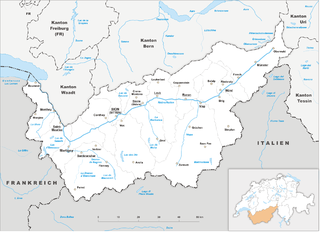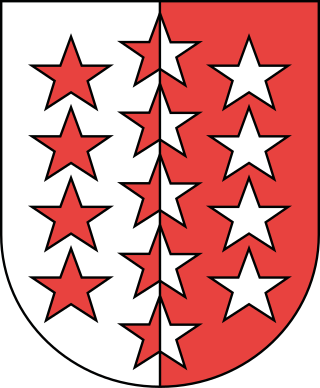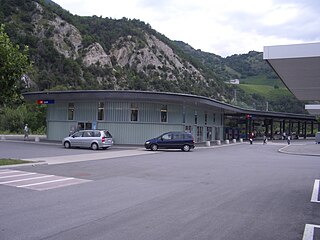The Canton of Valais is subdivided into districts and municipalities.
Contents
There is one former district, namely Raron District, which got divided into Westlich Raron District, Östlich Raron District.
The Canton of Valais is subdivided into districts and municipalities.
There is one former district, namely Raron District, which got divided into Westlich Raron District, Östlich Raron District.

Valais is divided into 13 districts, represented by the 13 stars on the coat of arms of Valais:

Valais, more formally the Canton of Valais, is one of the 26 cantons forming the Swiss Confederation. It is composed of thirteen districts and its capital and largest city is Sion. The flag of the canton is made of thirteen stars representing the districts, on a white-red background.

There are 122 municipalities in the canton of Valais, Switzerland.

Districts of Switzerland are a political subdivision for cantons. In the federally constituted Switzerland, each canton is completely free to decide its own internal organisation. Therefore, there exists a variety of structures and terminology for the subnational entities between canton and municipality, loosely termed districts. Most cantons are divided into Bezirke. They are also termed Ämter, Amtsbezirke, district or distretto. The Bezirke generally provide only administration and court organization. However, for historical reasons districts in cantons Graubünden and Schwyz are their own legal entities with jurisdiction over tax and often have their own Landsgemeinde.

Simplon was a department of the First French Empire. It was named after the Simplon Pass. It was formed in 1810, when the Rhodanic Republic was annexed by France. Its territory corresponded with that of the present-day Swiss canton of Valais.

The Diocese of Sion is a Latin Catholic ecclesiastical territory in the canton of Valais, Switzerland. It is the oldest bishopric in the country and one of the oldest north of the Alps. The history of the Bishops of Sion, of the Abbey of St. Maurice of Valais as a whole are inextricably intertwined.
The district of Raron was one of the 12 districts comprising the Republic of Wallis and after 1848 the canton of Valais in Switzerland. Today it is divided into two demi-districts, which are geographically separated by the District of Brig.

The A9 motorway, a motorway in western Switzerland, is a divided highway connecting from Ballaigues to southwestern Switzerland. It is part of the National Road N9.
Steg-Hohtenn is a municipality in the district of Raron in the canton of Valais in Switzerland. The municipality comprises the villages of Steg and Hohtenn.

Geneva Airport railway station is a train station located underground next to the terminal building of Geneva International Airport, in Grand-Saconnex, Geneva, Switzerland. It is located at the end of the standard gauge Lausanne–Geneva line of Swiss Federal Railways.

The coat of arms of the Swiss canton of Valais is in red and white, divided vertically with thirteen five-pointed stars in opposite colours. The stars represent the thirteen districts. It was introduced in 1815, when the Valais was detached from the French Department of Simplon to join the join the Swiss Confederacy.

The Simplon Railway is a line that links Lausanne in Switzerland and Domodossola in Italy, via Brig. The 20 km (12 mi)-long Simplon Tunnel is a major part of it. The line between Lausanne and Vallorbe is sometimes considered to form part of the line, making it 233 km (145 mi) long.

The Republic of the Seven Tithings was a state in what is now the Swiss canton of Valais during the early modern period, and an associate of the Old Swiss Confederacy.
The Evangelical Reformed Church in Valais or in French the Église réformée évangélique du Valais or Evangelisch-Reformierte Kirche des Wallis is a Reformed cantonal State church in Valais.

The Compagnie de la Ligne d’Italie, or Ligne d’Italie for short, was a former Swiss railway company that established in 1859. In 1874, the Ligne d'Italie became part of the Compagnie du Simplon. The Compagnie du Simplon, Ligne du Simplon or Simplon for short, merged into the Western Swiss Railways in 1881.

The Saint-Gingolph–Saint-Maurice railway is a single-track railway in Switzerland. It was opened on 14 July 1859 by the Ligne d’Italie. It connects Le Bouveret on Lake Geneva with Saint-Maurice. The line to the French–Swiss border near Saint-Gingolph was opened together with its continuation towards Évian-les-Bains on 1 June 1886. The line together with the French line to Évian is sometimes called the Tonkin Line, because construction workers saw similarities in the geological conditions to Indochina. It was the first railway line in the canton of Valais. A 691 metre-long tunnel had to be built on the approach to Saint-Maurice which is the only major structure of the line.

Raron railway station is a railway station in the municipality of Raron, in the Swiss canton of Valais. It is an intermediate stop on the Simplon line and is served by local trains only.

Leuk railway station is a railway station in the municipality of Leuk, in the Swiss canton of Valais. It is an intermediate stop on the Simplon line and is served by local and long-distance trains.

Sierre/Siders railway station is a railway station in the municipality of Sierre, in the Swiss canton of Valais. It is an intermediate stop on the Simplon line and is served by local and long-distance trains.

Martigny railway station is a railway station in the municipality of Martigny, in the Swiss canton of Valais. It is an intermediate stop on the standard gauge Simplon line of Swiss Federal Railways and the junction of the 1,000 mm Martigny–Châtelard and standard gauge Martigny–Orsières lines of Transports de Martigny et Régions and RegionAlps, respectively.

Occupied since prehistoric times, the canton of Valais saw the rise of an exceptional civilization during the Bronze Age. From the 4th century BC, four Celtic tribes shared its territory, which was incorporated into the Roman Empire by Augustus. The Gallo-Roman Valais, located on the important Great St Bernard Pass, was prosperous. Christianity was first established in 377, and a bishopric was opened in Martigny by 381 at the latest.